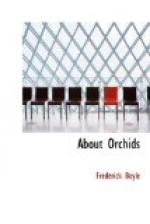I interpolate here a profound observation of Mr. Roezl. That wonderful man remarked that Odontoglossums grow upon branches thirty feet above the ground. It is rare to find them at thirty-five feet, rarer at twenty-five; at greater and less heights they do not exist. Here, doubtless, we have the secret of their reluctance to fertilize; but I will offer no comments, because the more one reflects the more puzzling it becomes. Evidently the seed must be carried above and must fall below that limit, under circumstances which, to our apprehension, seem just as favourable as those at the altitude of thirty feet. But they do not germinate. Upon the other hand, Odontoglossums show no such daintiness of growth in our houses. They flourish at any height, if the general conditions be suitable. Mr. Roezl discovered a secret nevertheless, and in good time we shall learn further.
To the Royal Horticultural Society of England belongs the honour of first importing orchids methodically and scientifically. Messrs. Weir and Fortune, I believe, were their earliest employes. Another was Theodor Hartweg, who discovered Odontoglossum crispum Alexandrae in 1842; but he sent home only dried specimens. From these Lindley described and classed the plant, aided by the sketch of a Spanish or Peruvian artist, Tagala. A very curious mistake Lindley fell into on either point. The scientific error does not concern us, but he represented the colouring of the flower as yellow with a purple centre. So Tagala painted it, and his drawing survives. It is an odd little story. He certainly had Hartweg’s bloom before him, and that certainly was white. But then again yellow Alexandraes have been found since that day. To the Horticultural Society we are indebted, not alone for the discovery of this wonder, but also for its introduction. John Weir was travelling for them when he sent living specimens in 1862. It is not surprising that botanists thought it new after what has been said. As such Mr. Bateman named it after the young Princess of Wales—a choice most appropriate in every way.
[Illustration: ODONTOGLOSSUM CRISPUM ALEXANDRAE Flower reduced to One Fourth Flower Stem to One Sixth]
Then a few wealthy amateurs took up the business of importation, such as the Duke of Devonshire. But “the Trade” came to see presently that there was money in this new fashion, and imported so vigorously that the Society found its exertions needless. Messrs. Rollisson of Tooting, Messrs. Veitch of Chelsea, and Messrs. Low of Clapton distinguished themselves from the outset. Of these three firms one is extinct; the second has taken up, and made its own, the fascinating study of hybridization among orchids; the third still perseveres. Twenty years ago, nearly all the great nurserymen in London used to send out their travellers; but they have mostly dropped the practice. Correspondents forward a shipment from time to time. The expenses of




